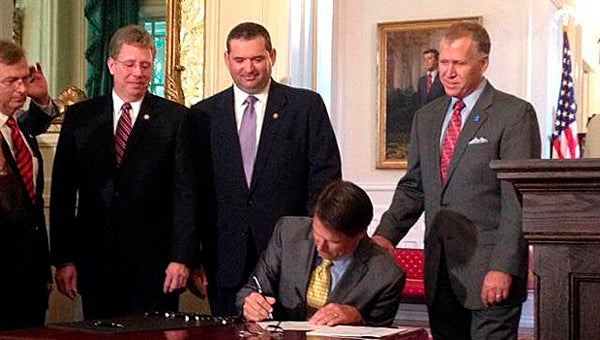A winding, country road
Published 12:39 am Sunday, March 8, 2015

NORTH CAROLINA DEPARTMENT OF TRANSPORTATION
DOTTED LINES: Gov. Pat McCrory is pictured signing the Strategic Mobility Formula into law in 2013. The date-driven plan prioritizes transportation projects in the state.
Every day, residents of Beaufort County start up their cars and trucks and blithely cruise to work, to school, to the grocery store and many other places. Local drivers might cross county lines and take off down the highway Greenville or, perhaps, to the beach or the mountains.
Rarely is a second thought is given to the fact that the roads exist, except when there’s traffic, or a detour or some road condition gets in the way of travel. But if one really sits down and thinks about it, the system of roads and highways stretching from one side of the state to the other is truly an amazing affair.
The state paved its first road in 1916. A one-cent gas tax was established to pay for road improvements in 1921. By the 1950s and 1960s the state’s highway system had developed into a complex network touching every part of the state. It became the way of commerce, facilitating the travel of goods and services.
Now, a century after the North Carolina Department of Transportation was created, the focus has turned to infrastructure. Just as cars zoom along a highway, transportation as a concept is not stagnant. As towns and populations grow, so must the infrastructure that will a get person from point A to point B in a reasonable amount of time. Just as it is the case with any physical object, time, the elements and general use tends to erode that object — repairs are needed, rebuilding needed, in some cases.
North Carolina Governor Pat McCrory is pushing the rebuilding of infrastructure, as has President Barack Obama on the national level. They’re talking long-term investment in roads and highways. For North Carolina, that’s a no small feat, considering that, at 80,000 miles, it has one of the largest state-maintained highway systems in the nation. The only one larger is Texas.
There might be those out there who would say that the $4.8 billion McCrory wants to dedicate to a 25-year transportation vision is excessive. Really, it’s not. It’s simply taking care of a valuable resource. The new Strategic Mobility Formula that will guide such a vision prioritizes when, where and what projects will be tackled. It’s a data-driven process that ostensibly removes political influence from determining where the work gets done. But it also leans heavily on population and use. So while U.S. highways 264 and 17 cleaving through Beaufort County may get due attention, the more rural areas of the county and surrounding counties may not see the same amount of attention as in the past.
Rebuilding transportation infrastructure is necessary. Let the rebuilding begin, but the hope is that rural North Carolina won’t get left behind on its winding, country roads.




